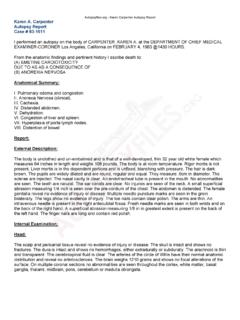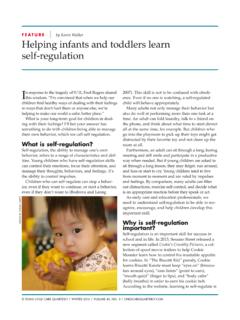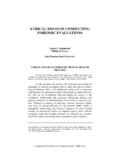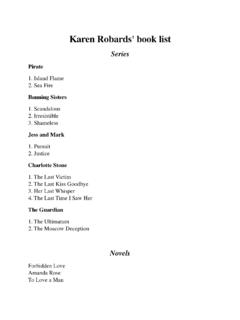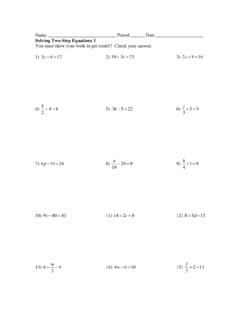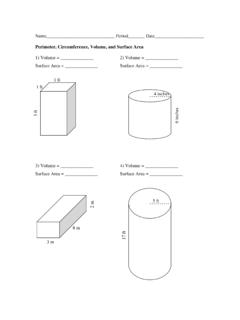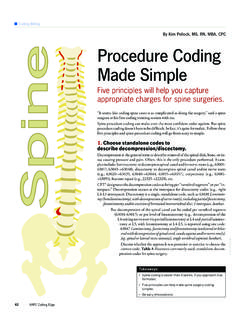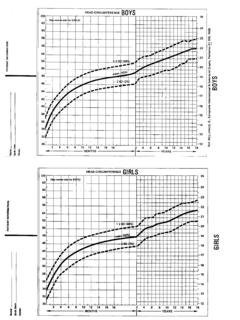Transcription of Early Childhood Corner - National Center for …
1 Early ChildhoodCornerMany states and school districts, aswell as Principles and Standards forSchool Mathematics: DiscussionDraft (NCTM 1998), recommend that al-gebra be taught in the Early childhoodyears. Although young children oftenunderstand much more than traditionallythought, adults can have difficulty concep-tualizing what would constitute appropri-ate algebra for the Early Childhood teachers and three university re-searchers are currently involved in aproject to define what alge-bra instruction can andshould be for young chil-dren. In this article, we dis-cuss the concept of equality,which is a crucial idea fordeveloping algebraic reason-ing in young about theEquals SignEven though teachers frequently use theequals sign with their students, it is inter-esting to explore what children under-stand about equality and the equals the start of this project, many teach-ers asked their students to solve the fol-lowing problem:8 + 4 = c + 5At first, this problem looked trivial tomany teachers.
2 One sixth-grade teacher,for example, said, Sure, I will help youout and give this problem to my students,but I have no idea why this will be of in-terest to you. This teacher found thatall twenty-four of her students thoughtthat 12 was the answer that should go inthe box. She found this result so interest-ing that before we had a chance to checkback with her, she had the other sixth-grade teachers at her school give this prob-lem to their students. As shown in table1, all 145 sixth-grade students given thisproblem thought that either 12 or 17should go in the did so many children havetrouble with this problem? Clearly, chil-dren have a limited understanding ofequality and the equals sign if they thinkthat 12 or 17 is the answer that goes inthe box.
3 Many young children do, how-ever, understand how to model a situa-tion that involves making things example, Mary Jo Yttri, a kindergar-ten teacher, gave her students the prob-lem 4 + 5 = c + 6. All the childrenthought that 9 should go in the box. Yttrithen modeled this situation with the chil-dren. Together, they made a stack of fourcubes, then a stack of five cubes. In an-other space, they made stacks of nine andsix cubes. Yttri asked the children if eacharrangement had the same number ofChildren sUnderstanding ofEquality: A Foundationfor AlgebraKaren P. Falkner,Linda Levi, andThomas P. CarpenterKaren Falkner, is a primary-gradeteacher at Lapham Elementary School, Madison, WI 53703. She iscurrently participating in a study of young children s algebraicthinking.
4 Linda Levi, and Thomas are affiliated with the Wisconsin Centerfor Educational Research, Madison, WI 53706. They both study thedevelopment of young children s algebraic by Kate Kline, Department of Math-ematics, Western Michigan University, Kalamazoo, MI 49008. Thiscolumn addresses the Early Childhood teacher s need to support youngchildren s emerging mathematics understandings and skills in acontext that conforms with current knowledge about the ways thatyoung children pre-K-K learn mathematics. Readers areencouraged to send manuscripts for this section to the CHILDREN MATHEMATICS cubes. The children knew that the group-ings did not have the same number of cubesand were able to tell her which one hadmore. Several children were able to tellthe teacher how they could make bothgroupings have the same number of after doing this activity, however, thechildren still thought that 9 should go inthe box in the incident surprised Yttri and theresearchers.
5 We had assumed that kinder-garten children would have little experi-ence with the equals sign and would notyet have formed the misconceptions aboutequality demonstrated by older kindergarten children, however, ap-pear to have enduring misconceptionsabout the meaning of the equals sign thatare not eliminated with one or two ex-amples or a simple explanation. This in-cident also illustrates that children asyoung as kindergarten age may have anappropriate understanding of equality re-lations involving collections of objects buthave difficulty relating this understandingto symbolic representations involving theequals sign. A concerted effort over an ex-tended period of time is required to estab-lish appropriate notions of should also be concerned aboutchildren s conceptions of equality as soonas symbols for representing number opera-tions are introduced.
6 Otherwise, miscon-ceptions about equality can become morefirmly entrenched. (See About the Math-ematics on p. 234.)As Behr, Erlwanger, and Nichols(1975); Erlwanger and Berlanger (1983);and Anenz-Ludlow and Walgamuth (1998)have documented, children in the elemen-tary grades generally think that the equalssign means that they should carry out thecalculation that precedes it and that thenumber after the equals sign is the answerto the calculation. Elementary school chil-dren generally do not see the equals signas a symbol that expresses the relationship is the same as. Not much variety is evident in howthe equals sign is typically used in the el-ementary school. Usually, the equals signcomes at the end of an equation and onlyone number comes after it.
7 With numbersentences, such as 4 + 6 = 10 or 67 - 10 - 3= 54, the children are correct to think ofthe equals sign as a signal to and Second GradesKaren Falkner is currently teaching a first and second grade class. Children typicallystay in the class for two years. The re-mainder of this article shows how the chil-dren in this class have progressed in theirunderstanding of equality over the some time, solving story prob-lems has been an integral part of math-ematics instruction in Falkner s class. Stu-dents are regularly asked to write numbersentences that show how they solved storyproblems. Falkner expected her studentsto be successful, therefore, when she firstasked them to solve the number sentence8 + 4 = c + 5.
8 To her surprise, the stu-dents answered the problem just as re-search indicated that they would. Mostput 12 in the box, and some extended thesentence by adding = 17. The discussionthat followed was interesting. Most saidthat 12 should go in the box because eightplus four equals twelve. The followingexcerpt illustrates the class discussion thattook place after students had worked onthe Is 8 + 4 the same as 12 + 5?Anna. NoFalkner. Then why did you put 12 inthe box?Anna. Because 8 + 4 equals 12. See?[Counting on her fingers] It s8,9,10,11,12. [Many children nod theirheads in agreement.]Falkner. Did anyone get another an-swer?Adam. It is Why?Adam. Because you have to have thesame amount on each side of the equalsTABLE 1 Percent of children offering various solutions to 8 + 4 = + 5 Answers GivenGrade7121712 and 17 Other 10797 0 14 1 and 265420 0 20 265510 14 15 3106020 5 5 47944 30 11 574845 0 0 608414 2 0 Number ofChildren42841742085742145 DECEMBER 1999233sign.
9 That s what the equals I see. Adam, would you saythat again?[Adam repeats his explanation. Otherchildren, considering Adam a classleader, listen attentively.]Falkner. [Gesturing at the numbersentence on the chalkboard.] So,Adam, you say that the equals signmeans that however much somethingis on one side of the equals sign, thesame amount has to be on the otherside of the equals sign. [Looking atthe rest of the class] What do youthink about what Adam said?Anna. Yes, but it has to be 12, be-cause that is what 8 + 4 No, Adam is right. Whateveris on one side of the equals sign hasto equal what is on the other side: 8+ 4 = 12 and 7 + 5 = 12, so 7 goes inthe class wrestled with this prob-lem for some time.
10 The equals sign is aconvention, the symbol chosen bymathematicians to represent the notionof equality. Because no logical reasonexists that the equals sign does not mean compute, Falkner thought that it wasappropriate to tell the class that sheagreed with Adam and Dan. Telling theclass what the equals sign meant wasnot, however, sufficient for many chil-dren to be able to adopt the standard use ofthe then chose to develop her stu-dents understanding of the equals signthrough discussion of true and false numbersentences; this discussion builds on the workof Robert Davis (1964). Falkner presentednumber sentences, similar to the following,to her students and asked whether the num-ber sentences were true or + 5 = 912 - 5 = 97 = 3 + 48 + 2 = 10 + 47 + 4 = 15 - 4 8 = 8 The children s reactions were interest-ing.
